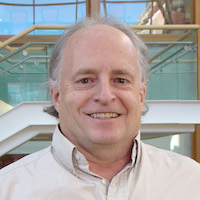Researchers conduct benchmark comparison of pore-scale models for multiphase flow
June 24, 2019
Multiphase flow in porous media is the simultaneous movement of two or more fluid phases through a porous solid. It occurs in many natural processes — picture avalanches and groundwater trickling through rock — and in several industrial uses, from nuclear reactors to extracting oil and gas from the subsurface layer of the earth, to sequestering carbon dioxide in the subsurface to reduce emissions into the atmosphere.

Dr. Cass Miller
In a new paper, researchers from the University of North Carolina at Chapel Hill share findings from the first-ever comprehensive comparison of pore-scale models for multiphase flow. Pore-scale models are predictive mathematical models that help scientists simulate how multiphase flow processes will play out, increasing understanding of natural events and enhancing the effectiveness of industrial applications.
“It has always been challenging to simulate unstable multiple fluid phases moving through a porous solid at the same time, considering varying qualities like wettability, viscosity and pore geometry,” said Cass T. Miller, PhD, a paper co-author and Okun Distinguished Professor of environmental sciences and engineering at the UNC Gillings School for Global Public Health. “That open challenge is why we have so many models in existence, and why this area of research is so active.”
The new study, published online June 24 by the journal PNAS, is titled, “Comprehensive comparison of pore-scale models for multiphase flow in porous media.” The study findings were the work of a 20-institution global collaboration, with Kelsey Bruning, a doctoral student and graduate research assistant in the environmental sciences and engineering department, also contributing from the Gillings School.
The researchers conducted quantitative comparisons between 14 state-of-the-art pore-scale models, including lattice Boltzmann, stochastic rotation dynamics, volume-of-fluid, level-set, phase-field and pore-network models. As the basis for the comparison, they used a data set from recent microfluidic experiments with precisely controlled pore geometry and wettability conditions, which offered an unprecedented bench-marking opportunity.
When they compared the results of the 14 participating models both qualitatively and quantitatively, using several standard metrics such as fractal dimension, finger width and displacement efficiency, the researchers found that no single method excelled across all conditions. Furthermore, thin films and corner flow models presented the most substantial modelling and computational challenges.
“The challenges posed in modeling these difficult — but extremely important — systems, as elucidated in this comprehensive study, will catalyze continued methods development by groups from around the world,” Miller said. “This work is a classic example of the joint use of experimental observations and mathematical modeling to advance our fundamental understanding of science that is of profound importance to society.”
Contact the Gillings School of Global Public Health communications team at sphcomm@listserv.unc.edu.
